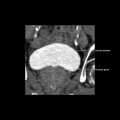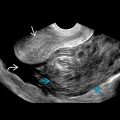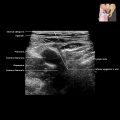TERMINOLOGY
Abbreviations
- •
Extrahepatic biliary structures
- ○
Gallbladder (GB)
- ○
Cystic duct (CD)
- ○
Right hepatic (RH) and left hepatic (LH) ducts
- ○
Common hepatic duct (CHD)
- ○
Common bile duct (CBD)
- ○
Definitions
- •
Proximal/distal biliary tree (follows direction of flow)
- ○
Proximal refers to portion of biliary tree that is closer in proximity to liver and hepatocytes
- ○
Distal refers to caudal end closer to ampulla and bowel
- ○
- •
Central/peripheral
- ○
Central refers to biliary ducts close to porta hepatis
- ○
Peripheral refers to higher-order branches of intrahepatic biliary tree extending into hepatic parenchyma
- ○
IMAGING ANATOMY
Overview
- •
Biliary ducts carry bile from liver to duodenum
- ○
Bile is produced continuously by liver, stored and concentrated by GB, and released intermittently by GB contraction in response to presence of fat in duodenum
- ○
Hepatocytes form bile → bile canaliculi → interlobular biliary ducts → collecting bile ducts → right and left hepatic ducts → CHD → CBD → intestines
- ○
- •
CBD
- ○
Forms in free edge of lesser omentum by union of CD and CHD
- ○
Length of duct: 5-15 cm, depending on point of junction of cystic and CHD
- ○
Descends posterior and medial to duodenum, lying on dorsal surface of pancreatic head
- ○
Joins with pancreatic duct to form hepaticopancreatic ampulla of Vater
- ○
Ampulla opens into duodenum through major duodenal (hepaticopancreatic) papilla
- ○
Distal CBD is thickened into sphincter of Boyden and hepaticopancreatic segment is thickened into sphincter of Oddi
- –
Contraction of these sphincters prevents bile from entering duodenum; forces it to collect in GB
- –
Relaxation of sphincters in response to parasympathetic stimulation and cholecystokinin (released by duodenum in response to fatty meal)
- –
- ○
- •
Vessels, nerves, and lymphatics
- ○
Arteries
- –
Hepatic arteries supply intrahepatic ducts
- –
Cystic artery supplies proximal common duct
- –
RH artery supplies middle part of common duct
- –
Gastroduodenal and pancreaticoduodenal arcade supply distal common duct
- –
Cystic artery supplies GB (usually from RH artery; variable)
- –
- ○
Veins
- –
From intrahepatic ducts → hepatic veins
- –
From common duct → portal vein (in tributaries)
- –
From GB directly into liver sinusoids, bypassing portal vein
- –
- ○
Nerves
- –
Sensory: Right phrenic nerve
- –
Parasympathetic and sympathetic: Celiac ganglion and plexus; contraction of GB and relaxation of biliary sphincters is caused by parasympathetic stimulation, but more important stimulus is from hormone cholecystokinin
- –
- ○
Lymphatics
- –
Same course and name as arterial branches
- –
Collect at celiac lymph nodes and node of omental foramen
- –
Nodes draining GB are prominent in porta hepatis and around pancreatic head
- –
- ○
- •
Gallbladder
- ○
~ 7-10 cm long, holds up to 50 mL of bile
- ○
Lies in shallow fossa on visceral surface of liver
- ○
Vertical plane through GB fossa and middle hepatic vein divides LH and RH lobes
- ○
May touch and indent duodenum
- ○
Fundus is covered with peritoneum and relatively mobile; body and neck attached to liver and covered by hepatic capsule
- ○
Fundus: Wide tip of GB, projects below liver edge (usually)
- ○
Body: Contacts liver, duodenum, and transverse colon
- ○
Neck: Narrowed, tapered, and tortuous; joins CD
- ○
CD: 3-4 cm long, connects GB to CHD; marked by spiral folds of Heister; helps to regulate bile flow to and from GB
- ○
- •
Normal measurements
- ○
CBD/CHD
- –
< 6-7 mm in patients without history of biliary disease in most studies
- –
Controversy about dilatation related to previous cholecystectomy and old age
- –
- ○
Intrahepatic ducts
- –
Normal diameter of 1st and higher-order branches < 2 mm or < 40% of diameter of adjacent portal vein
- –
1st- (i.e., LH duct and RH duct) and 2nd-order branches are normally visualized
- –
Visualization of 3rd and higher-order branches is often abnormal and indicates dilatation
- –
- ○
ANATOMY IMAGING ISSUES
Imaging Recommendations
- •
Patient should fast for at least 4-6 hours prior to US examination to ensure GB is not contracted after meal, ideally fasting for 8-12 hours (overnight)
- •
Complete assessment includes scanning liver, porta hepatis region, and pancreas in sagittal, transverse, and oblique views
- •
Subcostal and right intercostal transverse views help align bile ducts and GB along imaging plane for optimal visualization
- •
Usually structures are better assessed and imaged with patient in full-suspended inspiration and in left lateral oblique position
- •
Harmonic imaging provides improved contrast between bile ducts and adjacent tissues, leading to improved visualization of bile ducts, luminal content, and wall
- •
For imaging of gallstone disease, special maneuvers are recommended
- ○
Move patient from supine to left lateral decubitus position
- –
Demonstrates mobility of gallstones
- –
Gravitates small gallstones together to appreciate posterior acoustic shadowing
- –
- ○
Set focal zone at level of posterior acoustic shadowing
- –
Maximizes effect of posterior acoustic shadowing to confirm gallstone(s)
- –
- ○
- •
Overall gain is often lowered to remove reverberation artifact from GB; however, do not set gain too low such that true intraluminal echoes are obscured
Imaging Approaches
- •
Transabdominal US is ideal initial investigation for suspected biliary tree or GB pathology
- ○
Cystic nature of bile ducts and GB (especially if these are dilated) provides inherently high-contrast resolution
- ○
Acoustic window provided by liver and modern state-of-the-art US technology provides good spatial resolution
- ○
Common indications of US for biliary and GB disease include
- –
Right upper quadrant/epigastric pain
- –
Abnormal liver function test or jaundice
- –
Suspected gallstone disease
- –
Pancreatitis
- –
- ○
US plays key role in multimodality evaluation of complex biliary problems
- ○
- •
Supplemented by various imaging modalities, including MR/MRCP and CT
Imaging Pitfalls
- •
Common pitfalls in evaluation of GB
- ○
Posterior shadowing may arise from GB neck, Heister valves of CD, or adjacent gas-filled bowel loops
- –
May mimic cholelithiasis
- –
Scan after repositioning patient in prone or left lateral decubitus positions
- –
Make sure to increase transducer frequency when evaluating GB after evaluation of liver
- –
- ○
Food material within gastric antrum/duodenum
- –
Mimics GB filled with gallstones or GB containing milk of calcium
- –
During real-time scanning, carefully evaluate peristaltic activity of involved bowel with oral administration of water
- –
- ○
- •
Common pitfalls in evaluation of biliary tree
- ○
Redundancy, elongation, or folding of GB neck on itself
- –
Mimics dilatation of CHD or proximal CBD
- –
Avoided by scanning patient in full-suspended inspiration
- –
Careful real-time scanning allows separate visualization of CHD/CBD medial to GB neck
- –
- ○
Presence of gas-filled bowel loops adjacent to distal extrahepatic bile ducts
- –
Obscure distal biliary tree and render detection of choledocholithiasis difficult
- –
Scan with patient in decubitus positions or after oral intake of water
- –
- ○
Gas/particulate material in adjacent duodenum and pancreatic calcification
- –
Mimic choledocholithiasis within CBD
- –
- ○
Presence of gas within biliary tree
- –
May mimic choledocholithiasis, differentiated by presence of reverberation artifacts
- –
Limits US detection of biliary calculus
- –
- ○
Key Concepts
- •
Direct venous drainage of GB into liver bypasses portal venous system, often results in sparing of adjacent liver from generalized steatosis (fatty liver)
- •
Nodal metastasis from GB carcinoma to peripancreatic nodes may simulate primary pancreatic tumor
- •
Sonography: Optimal means of evaluating GB for stones and inflammation (acute cholecystitis); best done in fasting state (distends GB)
- •
Intrahepatic bile ducts follow branching pattern of portal veins
- ○
Usually lie immediately anterior to portal vein branch; confluence of hepatic ducts just anterior to bifurcation of right and main portal veins
- ○
CLINICAL IMPLICATIONS
Clinical Importance
- •
In patients with obstructive jaundice, US plays key role
- ○
Differentiates biliary obstruction from liver parenchymal disease
- ○
Determines presence, level, and cause of biliary obstruction
- ○
- •
Common variations of biliary arterial and ductal anatomy result in challenges to avoid injury at surgery
- ○
CD may run in common sheath with bile duct
- ○
Anomalous RH ducts may be severed at cholecystectomy
- ○
- •
Close apposition of GB to duodenum can result in fistulous connection with chronic cholecystitis and erosion of gallstone into duodenum
Function & Dysfunction
- •
Obstruction of CBD is common
- ○
Gallstones in distal bile duct
- ○
Carcinoma arising in pancreatic head or bile duct
- ○
Result is jaundice due to back up of bile salts into bloodstream
- ○
Embryologic Events
- •
Abnormal embryological development of fetal ductal plate can lead to spectrum of liver and biliary abnormalities, including
- ○
Polycystic liver disease
- ○
Congenital hepatic fibrosis
- ○
Biliary hamartomas
- ○
Caroli disease
- ○
Choledochal cysts
- ○
GALLBLADDER IN SITU










